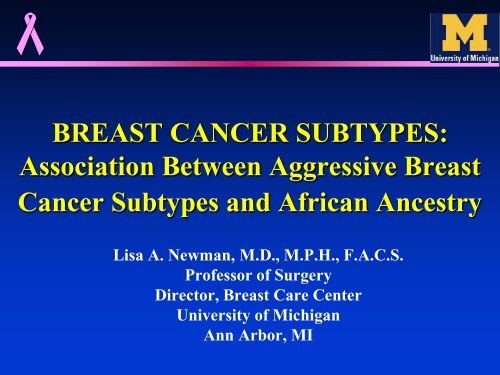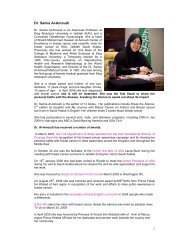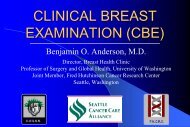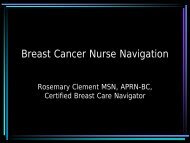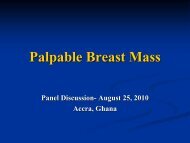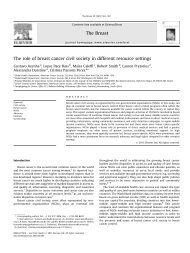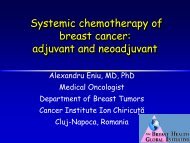3.4-Breast cancer subtypes (Newman) - Breast Health Global Initiative
3.4-Breast cancer subtypes (Newman) - Breast Health Global Initiative
3.4-Breast cancer subtypes (Newman) - Breast Health Global Initiative
You also want an ePaper? Increase the reach of your titles
YUMPU automatically turns print PDFs into web optimized ePapers that Google loves.
BREAST CANCER SUBTYPES:Association Between Aggressive <strong>Breast</strong>Cancer Subtypes and African AncestryLisa A. <strong>Newman</strong>, M.D., M.P.H., F.A.C.S.Professor of SurgeryDirector, <strong>Breast</strong> Care CenterUniversity of MichiganAnn Arbor, MI
Goals of <strong>Breast</strong> Cancer Treatment• Local/Regional Treatment: tocontrol/eliminate disease in breast andregional lymph nodes– Surgery– Radiation Therapy• Systemic Treatment: to control/eliminatedisease in distant organs– Chemotherapy– Endocrine/Hormonal Therapy– Other Targeted Therapy (e.g. Herceptin)
<strong>Breast</strong> Cancer Treatment• All breast <strong>cancer</strong> patients are at risk for having metastaticdisease in distant organs (liver, lungs, bones, etc)– Early-stage breast <strong>cancer</strong> pts more likely to have microscopicmetastases (microscopic, invisible disease; micrometastases)– Highest risk in pts with bulky, locally-advanced, node-positivebreast <strong>cancer</strong>• Systemic therapy can control distant organ metastases• Staging information (TNM) provides clues regarding risk ofmicrometastatic disease• Systemic therapy most likely to be successful if:– Micrometastatic burden is low (early-stage disease)– Systemic therapy is TARGETED to individual tumor biology
Systemic Therapy for <strong>Breast</strong> Cancer• Chemotherapy– “generic” systemic therapy: kills any rapidlydividingcells in the body• Endocrine/Hormonally-active therapy– Tamoxifen; Aromatase Inhibitors– Target ER-positive and/or PR-positive breast<strong>cancer</strong> cells• Herceptin/Trastuzamab– Targets HER2/neu-positive breast <strong>cancer</strong>
Systemic Therapy for <strong>Breast</strong> Cancer• Appropriate systemic therapy can improve breast<strong>cancer</strong> survival by 20-30%• Preoperative (neoadjuvant) systemic therapy– can convert locally-advanced/inoperable breast<strong>cancer</strong> to resectable disease– can improve ease of surgery for any bulky <strong>cancer</strong>• Success of systemic therapy:– COMPLETELY dependent upon having informationregarding tumor markers (ER, PR, and HER2/neu)
• What are breast <strong>cancer</strong> <strong>subtypes</strong>?• What is the relationship between breast<strong>cancer</strong> <strong>subtypes</strong> and systemic therapyfor breast <strong>cancer</strong>?
“Basal-like” breast <strong>cancer</strong>Gene expression profile•Most tightly clustered subgroupin gene expression arrays•CK 5/6 and 17 expression•P53 mutations•EGFR overexpression•Mostly “triple negative”BRCA1 connection•Gene expression similar•Morphology similarMorphology•High grade•Mainly ductal or medullary•High mitotic count•Scant stroma•Central necrosis•Pushing border•Lymphocytic infiltrate•Apoptotic figures
Sorlie et al. PNAS 2003ER++, PR++, G1,2 HER2 ISH pos “triple neg,” CK5/6+
Triple-Positive <strong>Breast</strong> CancerH&EER-Pos PR-Pos HER2/neu-PosTriple-Negative <strong>Breast</strong> CancerH&E ER-Neg PR-NegHER2/neu-Neg
Relevance of “Triple-Negative”<strong>Breast</strong> Cancer• Tumors that do not express the ER, PR, andHER2/neu markers are more likely to be basalsubtypetumors– Inherently aggressive biologic behavior– Triple-negativity used as a surrogate for basal subtype• Tumors that do not express the ER, PR, andHER2/neu markers have fewer systemic therapyoptions– Endocrine/hormonal therapy will be ineffective– Herceptin therapy will be ineffective– Chemotherapy IS effective
BREAST CANCER SUBTYPES:Association Between Aggressive <strong>Breast</strong>Cancer Subtypes and African Ancestry•Association initially suggested by observations ofdisparities in the breast <strong>cancer</strong> burden of AfricanAmericans and White/European Americans•Most available data therefore based upon studies ofAfrican American breast <strong>cancer</strong> pts and ER status
BREAST CANCER INAFRICAN AMERICANS• Overall lower lifetime incidence• Higher mortality• More advanced stage distribution• Younger age distribution• Increased frequency of adverseprognostic tumor features• Higher incidence of male breast <strong>cancer</strong>
NCDB: Frequency of ER-Negative Tumors byAge, Stage, and Income1998; N=170K; approximately 10% AAAfrican AmericanWhite AmericanAgeCategory(years)≤45 52% 35%46-60 41% 26%61-80 29% 17%Stage I 31% 17%II 42% 26%III 47% 32%IV 46% 30%Income
Frequency of ER-Neg <strong>Breast</strong> Cancer NOT Explained byStage Distribution:Age-specific incidence rates by ER status and raceHance, K. W. et al. J. Natl. Cancer Inst. 2005 97:966-975
Frequency of ER-Negative <strong>Breast</strong> CancerNOT Explained by Poverty:International Data on SES and ER Status• Glasgow, Scotland (Thomson et al, J Epi & Comm <strong>Health</strong>, 2001)– 35% ER-negative for affluent women compared to 52% ERnegativefor impoverished women– ER status missing for one-third of cases• Glasgow, Scotland (Carnon et al, BMJ 1994)– 51% ER-negative for affluent women compared to 52% ERnegativefor impoverished women• Sweden National <strong>Health</strong> Care System (Halmin et al ActaOncologica, 2008)– 37% ER-negative; no differences by SES• London, England (Bowen et al Br J Cancer, 2008)– 34% ER-neg for British Black women compared to 25% ER-negfor British White women; results unchanged by SES stratification
Dataset/Sample SizeCarey, 2006 97 premenopausal AA vs 164premenopausal WA women;Carolina <strong>Breast</strong> Cancer StudyFrequency of Triple-Neg CAAA WA P39% 16%
High-Risk <strong>Breast</strong> Cancer andAfrican Ancestry• Parallels between hereditarybreast <strong>cancer</strong> and breast <strong>cancer</strong>in women with African ancestry– younger age distribution– increased prevalence of ER-neg,aneuploid tumors– higher risk of male breast <strong>cancer</strong>• Is African ancestry associatedwith a heritable marker for highriskbreast <strong>cancer</strong> <strong>subtypes</strong>?•Unique opportunity to gain insights regarding etiologyof breast <strong>cancer</strong> disparities and the pathogenesis oftriple-negative breast <strong>cancer</strong>
<strong>Breast</strong> Cancer in African American,Sub-Saharan African, andWhite American WomenAfricanAfricanAmerican57 624%452%1%WhiteAmericanAverage Age at Diagnosis (years)Frequency of Male <strong>Breast</strong> Cancer80%60%40%20%0%Proportion with StageIII/IVProportion with High-Grade TumorsProportion with ER-Negative Tumors
Research Project: KATH-UMInternational <strong>Breast</strong> Cancer RegistryTo systematically evaluate African ancestry as arisk factor for ER/triple-negative, early onsetbreast <strong>cancer</strong>• Multicenter/international study– African Americans (UM; Henry Ford Hospital)– White Americans (UM; Henry Ford Hospital)– Ghanaians (Komfo Anoyke Teaching Hospital)• Document correlation between quantifiedextent of ancestry (via genotyping) and riskfor ER-negative/triple-negative breast <strong>cancer</strong>(via tumor studies)
Preliminary Results(in press, Cancer)HFH WAN=1,008HFH AAN=581GhanaN=75PValueMean Age 62.4 60.7 48.0 0.002Mean TumorSize1.95 2.30 3.20
HFH WAN=1,008HFH AAN=581GhanaianN=75P-ValueER Negative 21.9% 36.1% 76%
Patterns Among Locally-Advanced,Grade 3 TumorsHFH WA HFH AA Ghanaian P-ValueER Negative 50.0% 67.4% 77.2%
Other African Datasets• Huo et al (Olopade) JCO 2009– 378 breast <strong>cancer</strong>s from Nigeria and Senegal– 1996-2007– Mean age 45 yrs– 76% ER-negative– 73% triple-negative• Bird et al Ann Surg Onc 2008– 120 breast <strong>cancer</strong>s from Kenya– 2001-2007– Median age 47 yrs– 76% ER-negative– 44% triple-negative (subset of 34 tumors)
<strong>Breast</strong> Cancer Stem Cells
ALDH1 as a <strong>Breast</strong> CancerStem Cell MarkerArticleALDH1 Is a Marker of Normal and MalignantHuman Mammary Stem Cells and a Predictorof Poor Clinical OutcomeChristophe Ginestier, Max S. Wicha andGabriela Dontu, et alUniversity of Michigan, Ann Arbor MILaboratoire d'Oncologie Moléculaire, Centre deRecherche en Cancérologie de Marseille, FranceNovember 2007, Pages 555-567
ALDH-1 Staining byRace/Ethnicity• Ghanaian Cases:– 20/23 (87%)• University of Michigan White American cases:– 24/146 (19%)• French/European cases:– 102/345 (30%)• White American/European ER-negative cases– 39/80 (50%)
ALDH1/<strong>Breast</strong> CA Stem Cell Marker:Ghanaian <strong>Breast</strong> Cancer Case
THANK YOU!!!!!


